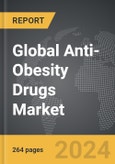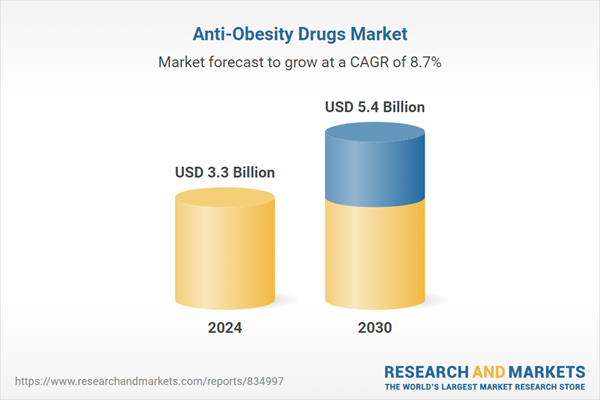The global market for Anti-Obesity Drugs was valued at US$3.3 Billion in 2024 and is projected to reach US$5.4 Billion by 2030, growing at a CAGR of 8.7% from 2024 to 2030. This comprehensive report provides an in-depth analysis of market trends, drivers, and forecasts, helping you make informed business decisions. The report includes the most recent global tariff developments and how they impact the Anti-Obesity Drugs market.
Segments: Type (Prescription Drugs, OTC Drugs).
Geographic Regions/Countries: World; United States; Canada; Japan; China; Europe (France; Germany; Italy; United Kingdom; and Rest of Europe); Asia-Pacific; Rest of World.
The analysts continuously track trade developments worldwide, drawing insights from leading global economists and over 200 industry and policy institutions, including think tanks, trade organizations, and national economic advisory bodies. This intelligence is integrated into forecasting models to provide timely, data-driven analysis of emerging risks and opportunities.
Global Anti-Obesity Drugs Market - Key Trends and Drivers Summarized
What Are Anti-Obesity Drugs and How Do They Work?
Anti-obesity drugs are medications designed to help individuals lose weight and maintain weight loss by targeting various physiological pathways involved in hunger, satiety, and fat absorption. These drugs function through different mechanisms such as appetite suppression, increasing feelings of fullness, reducing fat absorption from the diet, and enhancing energy expenditure. Commonly prescribed anti-obesity drugs include orlistat, which inhibits fat absorption in the intestines, and medications like liraglutide and phentermine-topiramate, which act on the central nervous system to reduce appetite. These drugs are typically prescribed for individuals with a Body Mass Index (BMI) of 30 or higher, or for those with a BMI of 27 or higher who have weight-related health conditions such as hypertension, type 2 diabetes, or dyslipidemia. The goal of these medications is to assist patients in achieving a sustainable weight loss that contributes to overall health improvement.How Are Anti-Obesity Drugs Utilized in Clinical Practice?
In clinical practice, anti-obesity drugs are part of a comprehensive weight management plan that includes lifestyle modifications such as diet, exercise, and behavioral therapy. Physicians typically evaluate a patient's health status, weight history, and weight-loss goals before prescribing these medications. The effectiveness and safety of anti-obesity drugs are closely monitored through regular follow-up appointments. Patients are often advised to adhere to a reduced-calorie diet and increase physical activity to maximize the benefits of the medication. In some cases, anti-obesity drugs are used as an adjunct to bariatric surgery, either preoperatively to reduce surgical risks or postoperatively to maintain weight loss. The integration of pharmacotherapy with lifestyle interventions aims to achieve long-term weight management and mitigate the health risks associated with obesity, such as cardiovascular disease, type 2 diabetes, and certain cancers.What Are the Recent Innovations in Anti-Obesity Drug Development?
The field of anti-obesity drug development has seen significant advancements driven by a deeper understanding of the biological mechanisms underlying obesity. Recent innovations include the development of GLP-1 receptor agonists like semaglutide, which mimic the effects of the gut hormone GLP-1 to enhance satiety and reduce appetite. Semaglutide has shown promising results in clinical trials, with significant weight loss outcomes compared to existing therapies. Another exciting area of research is the development of dual agonists that target multiple metabolic pathways simultaneously, such as tirzepatide, which acts on both GLP-1 and GIP receptors to regulate glucose and energy balance. Additionally, novel drug delivery systems, including long-acting injectables and oral formulations, are being explored to improve patient adherence and convenience. Advances in genomics and personalized medicine are also paving the way for more tailored obesity treatments, allowing for more precise targeting of specific patient populations based on genetic and metabolic profiles.What Factors Are Driving the Growth in the Anti-Obesity Drugs Market?
The growth in the anti-obesity drugs market is driven by several factors. The rising prevalence of obesity worldwide, exacerbated by sedentary lifestyles and unhealthy dietary habits, is a primary driver, creating a substantial demand for effective weight management solutions. Technological advancements in drug development, including novel mechanisms of action and innovative delivery methods, are enhancing the efficacy and safety profiles of anti-obesity medications, attracting more healthcare providers and patients. Increased awareness of the health risks associated with obesity, coupled with growing acceptance of pharmacotherapy as a viable weight management option, is also contributing to market growth. Regulatory approvals and favorable reimbursement policies in several regions are facilitating the accessibility and affordability of these drugs. Furthermore, the expanding research on the metabolic and genetic factors influencing obesity is leading to the development of more targeted and personalized treatments, further boosting the market. Collectively, these factors underscore the dynamic expansion of the anti-obesity drugs market, reflecting its critical role in addressing the global obesity epidemic.Report Scope
The report analyzes the Anti-Obesity Drugs market, presented in terms of units. The analysis covers the key segments and geographic regions outlined below.Segments: Type (Prescription Drugs, OTC Drugs).
Geographic Regions/Countries: World; United States; Canada; Japan; China; Europe (France; Germany; Italy; United Kingdom; and Rest of Europe); Asia-Pacific; Rest of World.
Key Insights:
- Market Growth: Understand the significant growth trajectory of the Prescription Drugs segment, which is expected to reach US$4.9 Billion by 2030 with a CAGR of a 8.5%. The OTC Drugs segment is also set to grow at 11.0% CAGR over the analysis period.
- Regional Analysis: Gain insights into the U.S. market, valued at $913.3 Million in 2024, and China, forecasted to grow at an impressive 7.9% CAGR to reach $812.2 Million by 2030. Discover growth trends in other key regions, including Japan, Canada, Germany, and the Asia-Pacific.
Why You Should Buy This Report:
- Detailed Market Analysis: Access a thorough analysis of the Global Anti-Obesity Drugs Market, covering all major geographic regions and market segments.
- Competitive Insights: Get an overview of the competitive landscape, including the market presence of major players across different geographies.
- Future Trends and Drivers: Understand the key trends and drivers shaping the future of the Global Anti-Obesity Drugs Market.
- Actionable Insights: Benefit from actionable insights that can help you identify new revenue opportunities and make strategic business decisions.
Key Questions Answered:
- How is the Global Anti-Obesity Drugs Market expected to evolve by 2030?
- What are the main drivers and restraints affecting the market?
- Which market segments will grow the most over the forecast period?
- How will market shares for different regions and segments change by 2030?
- Who are the leading players in the market, and what are their prospects?
Report Features:
- Comprehensive Market Data: Independent analysis of annual sales and market forecasts in US$ Million from 2024 to 2030.
- In-Depth Regional Analysis: Detailed insights into key markets, including the U.S., China, Japan, Canada, Europe, Asia-Pacific, Latin America, Middle East, and Africa.
- Company Profiles: Coverage of players such as Eisai Co. Ltd. (Japan), F. Hoffmann-La Roche Ltd. (Switzerland), GlaxoSmithKline Plc, Novo Nordisk A/S (Denmark), Rhythm Pharmaceuticals (US) and more.
- Complimentary Updates: Receive free report updates for one year to keep you informed of the latest market developments.
Some of the 23 companies featured in this Anti-Obesity Drugs market report include:
- Eisai Co. Ltd. (Japan)
- F. Hoffmann-La Roche Ltd. (Switzerland)
- GlaxoSmithKline Plc
- Novo Nordisk A/S (Denmark)
- Rhythm Pharmaceuticals (US)
- VIVUS Inc. (US)
Tariff Impact Analysis: Key Insights for 2025
Global tariff negotiations across 180+ countries are reshaping supply chains, costs, and competitiveness. This report reflects the latest developments as of April 2025 and incorporates forward-looking insights into the market outlook.The analysts continuously track trade developments worldwide, drawing insights from leading global economists and over 200 industry and policy institutions, including think tanks, trade organizations, and national economic advisory bodies. This intelligence is integrated into forecasting models to provide timely, data-driven analysis of emerging risks and opportunities.
What’s Included in This Edition:
- Tariff-adjusted market forecasts by region and segment
- Analysis of cost and supply chain implications by sourcing and trade exposure
- Strategic insights into geographic shifts
Buyers receive a free July 2025 update with:
- Finalized tariff impacts and new trade agreement effects
- Updated projections reflecting global sourcing and cost shifts
- Expanded country-specific coverage across the industry
Table of Contents
I. METHODOLOGYII. EXECUTIVE SUMMARY2. FOCUS ON SELECT PLAYERSIII. MARKET ANALYSISIV. COMPETITION
1. MARKET OVERVIEW
3. MARKET TRENDS & DRIVERS
4. GLOBAL MARKET PERSPECTIVE
UNITED STATES
CANADA
JAPAN
CHINA
EUROPE
FRANCE
GERMANY
ITALY
UNITED KINGDOM
REST OF EUROPE
ASIA-PACIFIC
REST OF WORLD
Companies Mentioned (Partial List)
A selection of companies mentioned in this report includes, but is not limited to:
- Eisai Co. Ltd. (Japan)
- F. Hoffmann-La Roche Ltd. (Switzerland)
- GlaxoSmithKline Plc
- Novo Nordisk A/S (Denmark)
- Rhythm Pharmaceuticals (US)
- VIVUS Inc. (US)
Table Information
| Report Attribute | Details |
|---|---|
| No. of Pages | 264 |
| Published | April 2025 |
| Forecast Period | 2024 - 2030 |
| Estimated Market Value ( USD | $ 3.3 Billion |
| Forecasted Market Value ( USD | $ 5.4 Billion |
| Compound Annual Growth Rate | 8.7% |
| Regions Covered | Global |









